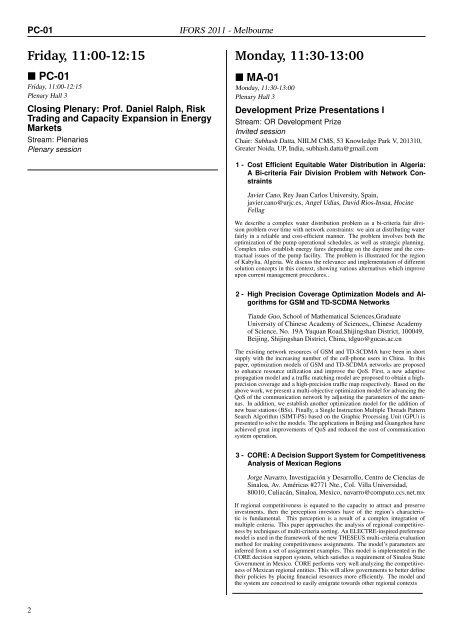Technical Sessions – Monday July 11
Technical Sessions – Monday July 11
Technical Sessions – Monday July 11
You also want an ePaper? Increase the reach of your titles
YUMPU automatically turns print PDFs into web optimized ePapers that Google loves.
PC-01 IFORS 20<strong>11</strong> - Melbourne<br />
Friday, <strong>11</strong>:00-12:15<br />
� PC-01<br />
Friday, <strong>11</strong>:00-12:15<br />
Plenary Hall 3<br />
Closing Plenary: Prof. Daniel Ralph, Risk<br />
Trading and Capacity Expansion in Energy<br />
Markets<br />
Stream: Plenaries<br />
Plenary session<br />
2<br />
<strong>Monday</strong>, <strong>11</strong>:30-13:00<br />
� MA-01<br />
<strong>Monday</strong>, <strong>11</strong>:30-13:00<br />
Plenary Hall 3<br />
Development Prize Presentations I<br />
Stream: OR Development Prize<br />
Invited session<br />
Chair: Subhash Datta, NIILM CMS, 53 Knowledge Park V, 201310,<br />
Greater Noida, UP, India, subhash.datta@gmail.com<br />
1 - Cost Efficient Equitable Water Distribution in Algeria:<br />
A Bi-criteria Fair Division Problem with Network Constraints<br />
Javier Cano, Rey Juan Carlos University, Spain,<br />
javier.cano@urjc.es, Angel Udias, David Rios-Insua, Hocine<br />
Fellag<br />
We describe a complex water distribution problem as a bi-criteria fair division<br />
problem over time with network constraints: we aim at distributing water<br />
fairly in a reliable and cost-efficient manner. The problem involves both the<br />
optimization of the pump operational schedules, as well as strategic planning.<br />
Complex rules establish energy fares depending on the daytime and the contractual<br />
issues of the pump facility. The problem is illustrated for the region<br />
of Kabylia, Algeria. We discuss the relevance and implementation of different<br />
solution concepts in this context, showing various alternatives which improve<br />
upon current management procedures..<br />
2 - High Precision Coverage Optimization Models and Algorithms<br />
for GSM and TD-SCDMA Networks<br />
Tiande Guo, School of Mathematical Sciences,Graduate<br />
University of Chinese Academy of Sciences„ Chinese Academy<br />
of Science, No. 19A Yuquan Road,Shijingshan District, 100049,<br />
Beijing, Shijingshan District, China, tdguo@gucas.ac.cn<br />
The existing network resources of GSM and TD-SCDMA have been in short<br />
supply with the increasing number of the cell-phone users in China. In this<br />
paper, optimization models of GSM and TD-SCDMA networks are proposed<br />
to enhance resource utilization and improve the QoS. First, a new adaptive<br />
propagation model and a traffic matching model are proposed to obtain a highprecision<br />
coverage and a high-precision traffic map respectively. Based on the<br />
above work, we present a multi-objective optimization model for advancing the<br />
QoS of the communication network by adjusting the parameters of the antennas.<br />
In addition, we establish another optimization model for the addition of<br />
new base stations (BSs). Finally, a Single Instruction Multiple Threads Pattern<br />
Search Algorithm (SIMT-PS) based on the Graphic Processing Unit (GPU) is<br />
presented to solve the models. The applications in Beijing and Guangzhou have<br />
achieved great improvements of QoS and reduced the cost of communication<br />
system operation.<br />
3 - CORE: A Decision Support System for Competitiveness<br />
Analysis of Mexican Regions<br />
Jorge Navarro, Investigación y Desarrollo, Centro de Ciencias de<br />
Sinaloa, Av. Américas #2771 Nte., Col. Villa Universidad,<br />
80010, Culiacán, Sinaloa, Mexico, navarro@computo.ccs.net.mx<br />
If regional competitiveness is equated to the capacity to attract and preserve<br />
investments, then the perception investors have of the region’s characteristic<br />
is fundamental. This perception is a result of a complex integration of<br />
multiple criteria. This paper approaches the analysis of regional competitiveness<br />
by techniques of multi-criteria sorting. An ELECTRE-inspired preference<br />
model is used in the framework of the new THESEUS multi-criteria evaluation<br />
method for making competitiveness assignments. The model’s parameters are<br />
inferred from a set of assignment examples. This model is implemented in the<br />
CORE decision support system, which satisfies a requirement of Sinaloa State<br />
Government in Mexico. CORE performs very well analyzing the competitiveness<br />
of Mexican regional entities. This will allow governments to better define<br />
their policies by placing financial resources more efficiently. The model and<br />
the system are conceived to easily emigrate towards other regional contexts




